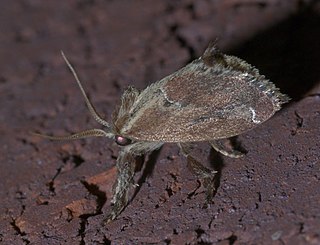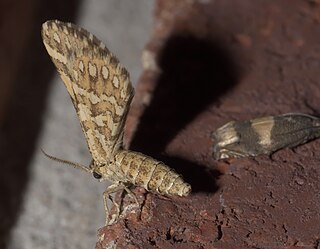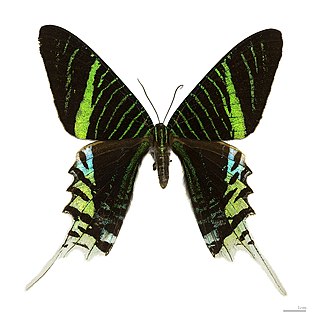Homolagoa is a monotypic moth genus of the family Noctuidae. Its only species, Homolagoa grotelliformis, is found in North America. Both the genus and species were first described by William Barnes and James Halliday McDunnough in 1912.
Cymatophora is a monotypic moth genus in the family Geometridae erected by Jacob Hübner in 1812. Its only species, Cymatophora approximaria, the giant gray moth, was described by the same author in the same year. It is found mostly in the southeastern United States. It is found in North America.
Eumacrodes is a monotypic moth genus in the family Geometridae described by Warren in 1905. Its only species, Eumacrodes yponomeutaria, first described by Achille Guenée in 1858, is found in the Caribbean and North America.
Holochroa is a monotypic moth genus in the family Geometridae. Its only species, Holochroa dissociarius, is found in North America. The species was described by George Duryea Hulst in 1887 and he described the genus nine years later in 1896.
Paota is a monotypic moth genus in the family Geometridae described by George Duryea Hulst in 1896. Its only species, Paota fultaria, was first described by Augustus Radcliffe Grote in 1882. It is found in North America.

Plataea is a genus of geometrid moths in the family Geometridae. There are about 11 described species in Plataea.
Ptychamalia is a monotypic moth genus in the family Geometridae described by Prout in 1932. Its only species, Ptychamalia dorneraria, was first described by William Barnes and James Halliday McDunnough in 1913. It is found in North America.

Snowia is a monotypic moth genus in the family Geometridae. Its only species, Snowia montanaria, is known from North America. Both the genus and species were first described by Berthold Neumoegen in 1884. It is found in North America.
Pseudhapigia is a monotypic moth genus of the family Notodontidae. Its only species, Pseudhapigia brunnea, is found in North America including its type location in Guadalajara, Mexico. The genus and species were first described by William Schaus in 1901.
Notela is a monotypic moth genus of the family Notodontidae. Its only species, Notela jaliscana, is found in North America. Both the genus and species were first described by William Schaus in 1901
Didugua is a monotypic moth genus of the family Notodontidae. Its only species, Didugua argentilinea, the silvered prominent, is found in North America. Both the genus and species were first described by Herbert Druce in 1891.
Noctuini is a tribe of owlet moths in the family Noctuidae. There are at least 520 described species in Noctuini.

Adoneta is a genus of moths in the family Limacodidae. There are at least four described species in Adoneta.
Apoda is a genus of slug caterpillar moths in the family Limacodidae. There are about 10 described species in Apoda.

Lithacodes is a genus of slug caterpillar moths in the family Limacodidae. There are about five described species in Lithacodes.

Lithariapteryx is a genus of sun moths in the family Heliodinidae. There are at least four described species in Lithariapteryx.
Antiplecta is a genus of scoopwing moths in the family Uraniidae. There are about five described species in Antiplecta.

Erosia is a genus of scoopwing moths in the family Uraniidae. There is one described species in Erosia, E. incendiata.

Fernaldella fimetaria, the green broomweed looper, is a species of geometrid moth in the family Geometridae. The species was first described by Grote and Robinson in 1870 It is found in Central and North America.

Philagraula is a genus of scoopwing moths in the family Uraniidae. There is one described species in Philagraula, P. slossoniae.












